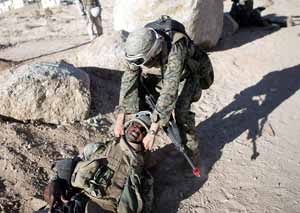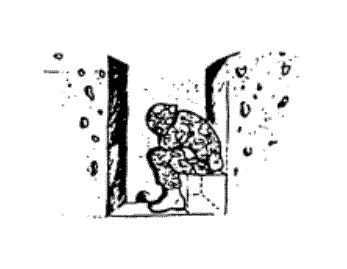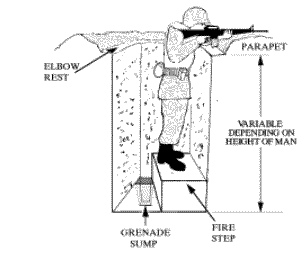|
Medical Education Division |
Operational Medicine 2001
Field Medical Service School
Student Handbook

FIELD
FORTIFICATION
TERMINAL LEARNING OBJECTIVE
ENABLING
LEARNING OBJECTIVES
OUTLINE
B.
BASIC REQUIREMENTS FOR FIELD
FORTIFICATIONS 1.
Allow effective employment of
weapons. Emplacements must
permit the effective use of the weapons for which they are designed.
This may limit protection which can be provided, and may influence the
design and/or depth of adjacent fortifications. 2.
Protection.
Protection should be provided against hazards except direct hits or a
close nuclear explosion. To obtain
maximum protection, fortifications should be as small as possible to limit the
effective target area for high trajectory weapons and airburst. 3. Simple and economic. The fortification should be strong and simple It should require as little digging as possible and be constructed with materials readily available. 4. Improvement/Development. Defensive fortifications should allow for continuous development to improve usefulness. Development can be accomplished in three steps: a. Dig in quickly. Here speed is the principal consideration and no special tools or materials are required. b. Improve with materials available. c. Refine, using stock materials. 5. Camouflage. Field fortifications should be built so that all can be camouflaged. It may not be practical to conceal a defensive position completely, but it should be camouflaged enough to prevent the enemy from spotting the position by ground observation. If possible, dummy positions should be constructed around your area. C. BASIC TYPES OF FIELD FORTIFICATIONS 1. Hasty emplacements. These are emplacements which are dug by Marines when in contact with the enemy, when time and materials are limited. They are used when there is no natural cover; they are good only for short periods of time and only against direct fire. a. Shell Crater. A crater made from a shell or bomb of adequate size offers immediate cover and concealment and can be quickly made into a hasty emplacement. b. Improved Crater. A crater dug with a steep face on the side towards the enemy which provides the occupant with a firing position. c. Skirmisher Trench. The trench is a shallow pit type emplacement which provides a temporary, open prone firing position. A low silhouette is presented, and it affords protection to a limited extent from small arms fire. It can be developed further into a prone emplacement. d. Prone Emplacement. This is a further refinement of the skirmisher’s trench. It serves as a good firing position and provides better protection against small arms and direct fire weapons, than does the improved crater or skirmisher trench. e. Rocks, Snow, and Ice. May provide limited protection by piling up rocks, chunks of ice, or packed snow. Icecrete (mixture of dirt and water) is an effective arctic building material which provides protection against small arms fire. 2. FIGHTING HOLES. They are individual Marine/Corpsman basic defensive positions which provide excellent protection from small arms fire. There are two types of fighting holes: a. One-man fighting hole. b. Two-man fighting hole. c. Both fighting holes are basically constructed in the same manner, except that the dimensions and positions of the common parts vary. D.
COMMON PARTS OF ONE-MAN AND
TWO-MAN FIGHTING POSITIONS 1. Firestep. There is one firestep for one-man fighting positions; there are two firesteps for two-man fighting positions. The depth of the firesteps varies, depending on the height needed to obtain a comfortable firing position by the occupant (three to five feet) when the occupant is crouching or sitting, there should be a two foot overhead clearance to provide protection against the crushing action of tanks. 2. Watersump. This is dug at one end of the fighting hole to collect water or accommodate the feet of a seated occupant. The water sump may simply provide a collection basin from which water can be bailed.
E.
ADVANTAGES AND DISADVANTAGES OF
FIGHTING POSITIONS 1.
One-man fighting position. a. Advantages: 1) It affords better protection. 2) Unit can cover wider frontage. b. Disadvantages: 1) When the occupant is resting, his portion of the perimeter is not covered. 2) Moral is lower. 2. Two-man fighting positions. a. Advantages: 1) One man can provide protection while the other man digs. 2) It affords rest and relief; as one man rests, the other observes. 3) Firing positions can be manned for longer periods of time. 4) If a man is hurt, the position is still occupied. 5) Moral is higher. b. Disadvantages: 1) A direct hit could cause two casualties 2) The area that could be covered is greatly reduced. REFERENCES Marine Rifle Squad, FMFM 6-5, Dec 1991 Combat in Fortified and Built-up Areas, FM 31-50 Field Medical Service School
Approved for public release; Distribution is unlimited. The listing of any non-Federal product in this CD is not an endorsement of the product itself, but simply an acknowledgement of the source. Operational Medicine 2001 Home · Military Medicine · Sick Call · Basic Exams · Medical Procedures · Lab and X-ray · The Pharmacy · The Library · Equipment · Patient Transport · Medical Force Protection · Operational Safety · Operational Settings · Special Operations · Humanitarian Missions · Instructions/Orders · Other Agencies · Video Gallery · Phone Consultation · Forms · Web Links · Acknowledgements · Help · Feedback
*This web version is provided by The Brookside Associates Medical Education Division. It contains original contents from the official US Navy NAVMED P-5139, but has been reformatted for web access and includes advertising and links that were not present in the original version. This web version has not been approved by the Department of the Navy or the Department of Defense. The presence of any advertising on these pages does not constitute an endorsement of that product or service by either the US Department of Defense or the Brookside Associates. The Brookside Associates is a private organization, not affiliated with the United States Department of Defense. |




